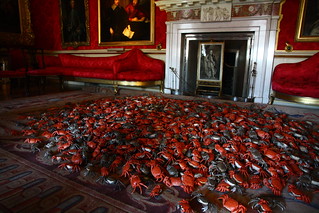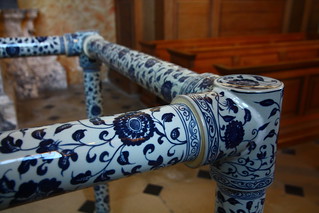Ai Weiwei is best known these days as a thorn in the side of the Chinese government; having used his artistic practice to critique everything from China's territorial claims to corrupt officials' complicity in shoddy building practices (which claimed the lives of dozens of pupils when a school collapsed in an earthquake), and other provocations (such as the destruction of Ming vases in the name of questioning the nature of authenticity) have not won him any sympathy among China's more conservative politicians. For this reason, he remains under house arrest. Nonetheless, although he has not been allowed to travel abroad, he has managed to be intimately involved in the planning of his exhibitions outside China, working with the curators over the internet.
Ai's artistic practice as we know it took form in New York, where he lived for a decade from 1983. His earlier works were in the readymade tradition pioneered by Marcel Duchamp; found or mass-manufactured objects repurposed into statements (such as two raincoats buttoned together on a coat rack, a statement on the AIDS epidemic of the 1980s). His move back to China in 1993, and engagement with the rapidly changing society in the age of Deng Xiaoping's market reforms, provided a cornucopia of new subjects for his work.
Ai's conceptual tactics have often been subtly mischievous;
 he might take an object and transform it (such as glazing a Ming vase in automotive lacquer, destroying its value as an antiquity but transforming it into a statement about modernisation), or replicate it from an incongruous material (replicas of surveillance cameras and gas masks, carved out of expensive marble),
or, occasionally, relying on the sorts of subversive wordplay the Chinese government's not too fond of these days (He Xie, a collection of hundreds of porcelain crabs, alludes to the Chinese term for “river crab” being homophonous with “harmony”, the standard government euphemism for censorship and suppression of dissent).
he might take an object and transform it (such as glazing a Ming vase in automotive lacquer, destroying its value as an antiquity but transforming it into a statement about modernisation), or replicate it from an incongruous material (replicas of surveillance cameras and gas masks, carved out of expensive marble),
or, occasionally, relying on the sorts of subversive wordplay the Chinese government's not too fond of these days (He Xie, a collection of hundreds of porcelain crabs, alludes to the Chinese term for “river crab” being homophonous with “harmony”, the standard government euphemism for censorship and suppression of dissent).
In the Blenheim Palace show, the subtlety is taken to a new level. Whereas in an ordinary exhibition, one might expect the exhibits to be arrayed in a well-defined space, its boundaries defining what is and isn't in the exhibition, this exhibition does us no such favours; instead, Ai's works are placed in various locations in the palace, juxtaposed with the rich assortment of its existing contents. In the bedchamber where Winston Churchill was born, a pair of handcuffs carved out of wood lies, perhaps suggestively, on the quilt; on the ornately papered wall behind the bed, a simple wooden frame containing a human profile made from a bent coathanger takes its place next to landscapes painted in oils. Two Ming vases emblazoned with the word “Caonima”, in the style of the Coca-Cola logo, stand on an antique marble table.
 A rug in a drawing room is covered with the aforementioned ceramic river crabs, and in an adjacent room stands a cluster of traditional Chinese stools, taken from peasant houses, and stuck together into a shape not unlike a large chestnut. Under the oil paintings in a state room, two chairs carved of uncomfortable-looking marble stand opposite from two antique seats, and in the Long Library, the walls are hung with photographs from Ai's Study of Perspective series, of the artist's hand making a rude gesture at various world landmarks; at the other end, a blind marble security camera watches the scene. (During the day, adding to the incongruity, a small orchestra was playing Christmas carols in the middle of the scene.) The palace's chapel is home to a large cube, made as if of steel pipes replicated in traditionally patterned porcelain. More subtle interlopers are stowed in various places: traditionally patterned porcelain owl houses (an absurd, yet almost plausible, object) stnd in the Great Hall, and a porcelain watermelon beside a seat almost blends into the rich ostentation of the palace's contents. Outside are yet more objects, from ceramic spheres in a park to fake oil slicks, made from porcelain, under a tree in the Secret Garden. The overall effect is to make one suspicious of everything around one: is this one of the Duke of Marlborough's heirlooms or a subtle subversion deftly inserted by a mischievous artist half a world away?
A rug in a drawing room is covered with the aforementioned ceramic river crabs, and in an adjacent room stands a cluster of traditional Chinese stools, taken from peasant houses, and stuck together into a shape not unlike a large chestnut. Under the oil paintings in a state room, two chairs carved of uncomfortable-looking marble stand opposite from two antique seats, and in the Long Library, the walls are hung with photographs from Ai's Study of Perspective series, of the artist's hand making a rude gesture at various world landmarks; at the other end, a blind marble security camera watches the scene. (During the day, adding to the incongruity, a small orchestra was playing Christmas carols in the middle of the scene.) The palace's chapel is home to a large cube, made as if of steel pipes replicated in traditionally patterned porcelain. More subtle interlopers are stowed in various places: traditionally patterned porcelain owl houses (an absurd, yet almost plausible, object) stnd in the Great Hall, and a porcelain watermelon beside a seat almost blends into the rich ostentation of the palace's contents. Outside are yet more objects, from ceramic spheres in a park to fake oil slicks, made from porcelain, under a tree in the Secret Garden. The overall effect is to make one suspicious of everything around one: is this one of the Duke of Marlborough's heirlooms or a subtle subversion deftly inserted by a mischievous artist half a world away?
Alas, this exhibition closes this coming Saturday, so those wishing to see it must hurry. However, it should be worth it.